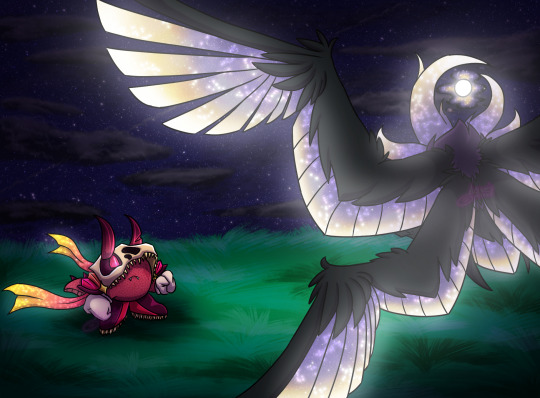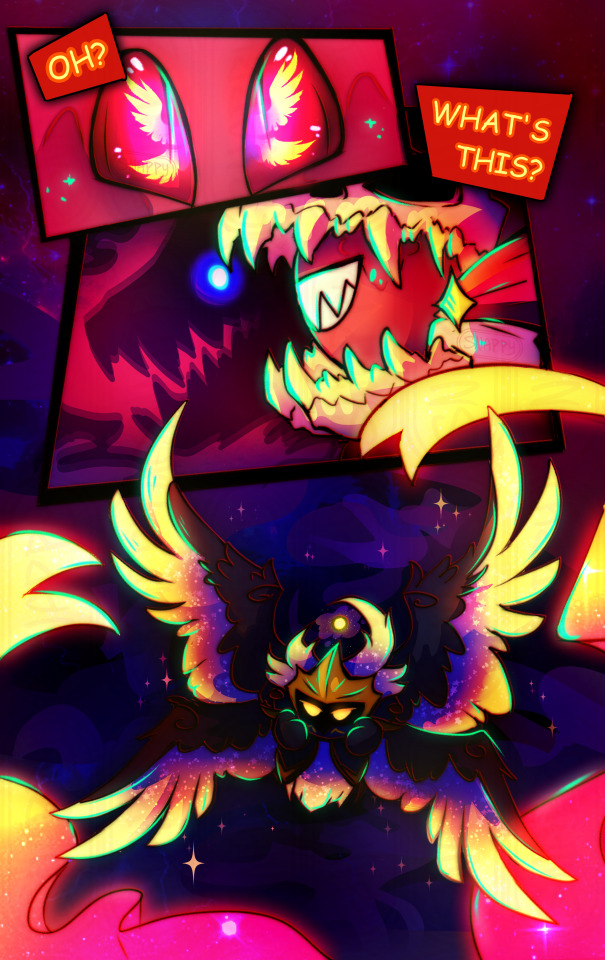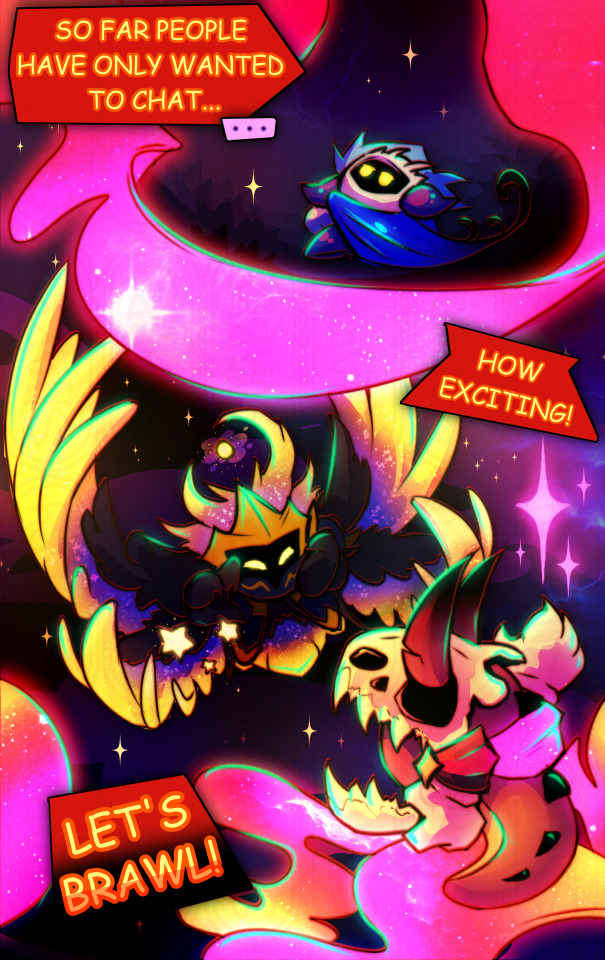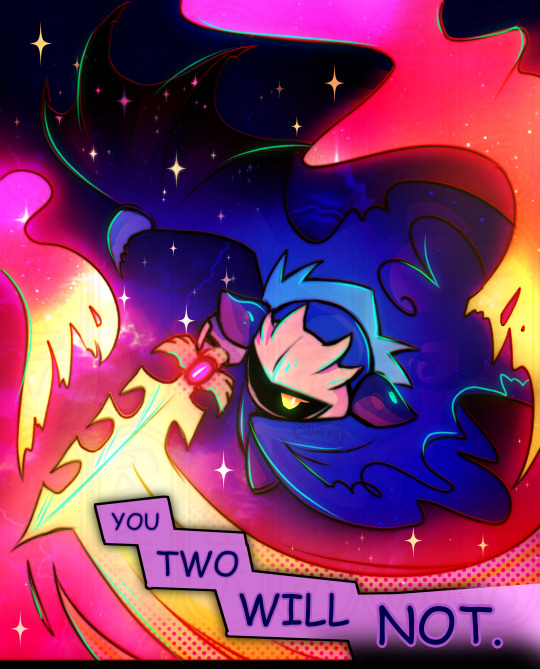#i REALLY love the scale texture you gave Meteor its SO GOOD ITS SO GOOD
Explore tagged Tumblr posts
Note
(honestly just wanted an excuse to draw Sir Meteor, cause he's got such an awesome design tbh, but Phosphor is here to cause some chaos for a fellow contestant >:3) Phosphor : 'Ey! I know the Spoilsport over there -gestures to Meta Knight- said that the tournament isn't an actual fight, but how about a friendly lil' spar? you def look like a fun challenge!




Your presence on Planet Popstar is only tolerated for the tournament and I strictly uphold a no fighting policy. Especially because I know the tragedy that you bring.
@kirbyoctournament It seems that Sir Meteor's explosive entry made certain knights very distrustful of our dinosaur... or was it something else entirely? I wonder if any other familiar faces have followed as well...
<< Prev Ask ✨ Next Ask >>
>> Unfamiliar with Sir Meteor? Click here for more!
#snappy's art tag#my art#meta knight#kirby#sent to snappy#Kirby OC: Sir Meteor#Kirby OC: Lady Phosphor#galaxia#THAT YOU SO MUCHHHH FR THE ART BTW!!!!!!!!!!!!#the art IS SO GOOD and i had to go ham in response#i REALLY love the scale texture you gave Meteor its SO GOOD ITS SO GOOD#it inspired me a lot :D#image description in alt
91 notes
·
View notes
Text
Frugality and Arte Povera
Painting has always presented a problem to me. Use of paint
Don’t get me wrong, I love painting and the relationship between the an acrylic brushstroke and its respective canvas can spawn a subtle beauty of form, texture and colour, I find the actual removal of paints from their nice metal tubes to be all too distressing. I hate the idea of having one crumpled tube of white or black amongst a collection of other barely used paints. Not because I am a clean freak (take a look at my desk if you think that) but because I am all too painfully aware of how expensive paints are now. I’ve been lucky in that I have gotten most of my paints for free, but I know eventually those paints will run out and I’ll have to buy more, and then those paints will run out and I’ll have to but more, and then those paints will run out and I’ll have to but more, etc.
On top of this I’ve recently been told as part of a paint workshop that I will have to access the next grade of paint quality, an exciting upgrade for some but to me it seems more of a burden than anything. Because once again, I am faced with the eternal problem of things costing money. It’s a problem that as a student I am more than aware than ever. I have to plan strategically if I want to buy paints: What colours are essential? What quality grade is necessary? How much should I actually purchase? I feel that in the future it will become a much larger problem than I hope it should be. The only way I can realistically combat is to not splurge on student or artist level acrylics, and stick to my low tier paints. But then of course I will miss on the subtle mixes of colour and smoothness of the higher grades. But maybe there’s a way around that.
I’m always interested in experimentation, especially with paint, mainly in the different ways I can make it smoothly or ruggedly move across the paper, but there’s clearly something I’m missing. Instead of simply using the paint alone I need to really push the physicality of the paint to its limits. I’ve had an idea for a while of mixing multiple different fluids into acrylics and recording their effects, to see if any of them have interesting visuals to them, and now seems to be the best time to look into the idea.
According to the Oxford Dictionary frugality is “The quality of being economical with money or food; thriftiness.” a sought after and somewhat necessary trait for some, but the definition itself isn’t as beefy as I wish it were, I need to know why it is a favourable. Behavioural science suggest frugality is the tendency to acquire goods and services in a restrained manner, and resourceful use of already owned goods and services to achieve a long-term goal. In simple terms, one must buy in small and measured amounts at the longest possible intervals in order to save money. Sounds simply but in experience can take quite a lot of planning and subsequent willpower. Common strategies of the frugal lifestyle include the reduction of waste, eliminating common costly habits, efficiency, avoiding economic traps, defying expensive social norms, avoiding advertising, embracing low-cost options, using barter when possible, staying informed about local markets, and stopping instant gratification by self-restraint.
The original concept of frugality as a subject was to be distrustful of ‘expert’ knowledge from commercial markets and corporate culture to instead focus on the preferred economic, material, and spiritual ideals of a small community or the individual. Many communities see frugality as an aspect of spirituality, helping a person become enlightened to the true measures of life as well as eliminating the aspects of a destructive lifestyle based on hedonism. Quakers and Puritans have adopted this lifestyle for such reasons, so they can save money and allocate it for more charitable efforts.
Frugality can not only help save money for the future but also assist a positive health by eliminating destructive and cost-heavy habits such as smoking, drinking, and drug use. Paired with ultimate goal of saving as such money as possible and the lifestyle being seen as a separated ideal from the conventional materialism of many people’s lives, it has been seen as either being an extremely beneficial method of cost-cutting in its simplest examples, and a more disdained practice in its more extreme lengths. People see planning economically and using coupons as clever, others see it as cheap, most see skip diving to be too far. But personally I’m all for any example of it. Mainly the more spontaneous aspects of it, rather than the fully planned spreadsheets of the cost:volume ratios, monthly charters and coupon-cutting. And Lord knows I’m not above picking things of the street, just look back at my sculpture project for evidence of that. But maybe it is time to change, think more on the numbers side of things.
I purchased some paints from my local Wilko, twelve 200ml tubes of acrylic in the colours Viridian, White, Rose, Black, Cerulean Blue, Cadmium Red, Ultramarine Blue, Crimson Red, Burnt Sienna, Burnt Umber, Lemon Yellow, and Sap Green at a cost of £24 total. Pretty expensive all things considered, especially for such low quality acrylics, but that low quality, especially the slickness of the surface and unsubtle block colours have a certain necessity to them. The cheapness of the quality relates back into why I brought them, because I’m cheap. The second part of the painting process, the supports, were easily acquired, I simply picked up a collection of MDF offcuts from the workshop downstairs. Normally I would have used paper but I didn’t want to get those ugly dented effects or go through the process of stretching onto a board, as that would have costed more money and taken time until I could actually paint. I did a few small tests at the beginning of the painting into different painting techniques, as it has been a while since I’ve painted for prolonged periods, I tested with impressionist and reductive methods but I settled on using small tabs of cardboard to layer and blend blocks of pure colour atop one another, finding the way the colours relate and the built texture to be quite nice.
During a group tutorial it was suggested instead of using free MDF from the workshop I instead return to the found object motif of my previous sculpture project as well as research some artists who use found objects in their work. I took to this idea and collected some pieces of disused wood from my surrounding area, many of which were dampened and rotting, making them quite delicate, a feature I didn’t find out until I started painting, which was quite annoying. Some of the wood scraps have been pre-painted and varnished, making them smooth to the touch much like the MDF I previously used while others were raw and rough, making for an interesting textural relationship between the support and the paint. Unlike the MDF, these wooden supports aren’t thin enough to fit into my sketchbook, meaning I’ll have to scan them into my sketchbook, eliminating the texture, which is unfortunate.
My tutor gave me a list of interesting artists to look at and study for the found object motif I’ve been running with, but I felt like a link between most of them was too much of a stretch. I did however particularly enjoy the work of the Arte Povera (which literally translates to ‘Poor Art’) movement which was suggested to me. A late 60’s-early 70’s Italian art movement and originally a response to the established government, industries and culture of Italy, mainly with a focus on simplicity, much like the Minimalist Art movement before it, except on a grander scale, with a three dimensional focus, emphasis on more fluid forms, and a utilization of found or recycled objects including soil, rags and twigs in an effort to disrupt the commercial aspects of modern Italian art. The movement was paired with a series of supposed concepts and trends such as:
A return to simple objects and messages
The body and behaviour are art
The everyday becomes meaningful
Traces of nature and industry appear
Dynamism and energy are embodied in the work
Nature can be documented in its physical and chemical transformation
Explore the notion of space and language
Complex and symbolic signs lose meaning
Ground Zero, no culture, no art system, Art = Life
The focus on the found is mainly why I focused on the movement, but I’ve also come to enjoy the fluid forms of many of the sculptures, specifically the use of Anti-Form, a style of sculpture born in the United States which embraced organic processes and a level of chance, in a sense treating the object in a certain way and then leaving it to possess its own inherent qualities rather than the artist imposing restrictions on it. An example I found of this is Lynda Beglis’ Quartered Meteor, a sculpture in which layers of lead and steel are melted on top of each other, forming an appearance of cooled lava. I find the fluidity and methodology of the sculpture to be quite fascinating and relatable to my project, as with the paints and fluids I am mixing, the results are mostly unknown and produce often unperticable effects inherent to the materials I use, much like the ideas of Anti-Form but on a textural basis instead.
Sources used:
https://en.wikipedia.org/wiki/Frugality
http://www.the-frugality.com/
https://en.wikipedia.org/wiki/Arte_Povera
http://www.tate.org.uk/art/art-terms/a/arte-povera
http://www.tate.org.uk/art/art-terms/a/anti-form
http://www.tate.org.uk/art/artworks/benglis-quartered-meteor-t13353
1 note
·
View note